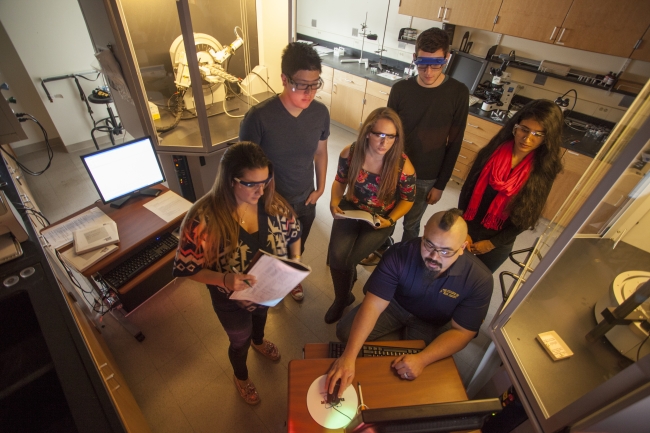You have /5 articles left.
Sign up for a free account or log in.

Undergraduates participate in research at the College of New Jersey.
The College of New Jersey
Lots of faculty members outside research universities say that teaching a full course load takes up most of their time, service obligations eat up the rest, and research is something they must pursue largely on their own. A preliminary study of how faculty members actually spent their working hours at Boise State University, for example, found just that.
Lots of faculty members also say that the system has to change – that it’s unsustainable and incentivizes the wrong things – but they aren’t sure how. Which duties to keep? Which to take away?
The College of New Jersey, a public liberal arts institution near Trenton, might provide some insight. Professors there say that a radical overhaul of the curriculum, centered on undergraduate research and the teacher-scholar model, has benefited both students and faculty members. The faculty members say that, unlike many of their peers elsewhere, they’re credited for how much work they do, and what kind. That, in turn, encourages them to take risks in their research and teaching in ways that help students.
“Part of this big academic transformation was concurrently thinking about faculty workload models, and fundamentally making that shift from separate research and teaching cultures to the scholar-teacher culture,” said Jeffrey M. Osborn, dean of the School of Science. “We want undergraduate research to be built into the faculty workload system.”
Back in 2003, the College of New Jersey looked into updating its traditional liberal arts curriculum in a way that prioritized data-driven, “high-impact” teaching practices – primarily engaging undergraduates in research. Both faculty members and administrators knew that process would have major implications for faculty workload (if they did it right, that is). So both groups made a concerted effort to work collaboratively on the project, working through and with the college’s Faculty Senate and American Federation of Teachers-affiliated union.
The process went quickly for so large a project: it took less than a year. By 2004-5, the college piloted its new curriculum and faculty workload model. Under the new system, faculty members were no longer teaching four courses per semester (and students were taking four courses instead of five, for one more credit each). Instead, professors now were teaching three courses, or 18 weighted hours, on average. Each course they did teach was to be more rigorous and engage students – mostly all undergraduates – in high-level research, to the extent possible.
In the rest of their six weighted working hours, professors were to embrace their own research, involving students where they could.
Professors also were encouraged to lead independent or “group” independent research sessions, for which they receive various amounts of workload credit, based on department- or college-level guidelines. In the natural sciences, for example, one independent research student equals 0.5 weighted credit hours, to a maximum of three credit hours per year. Professors in some of the humanities disciplines are encouraged to lead group independent studies for a full three weighted hours, or a single course release, per year.
Professors are also eligible to apply for support for scholarly activity (SOSA) course releases to focus on their research.
Beyond that, the college developed a Mentored Undergraduate Summer Experience (MUSE) program, which invites students to spend eight weeks on campus doing research. Professors are paid a stipend for participation.
To make the research immersion authentic, professors have an unusual amount of leeway in designing their courses, especially in the humanities and social sciences. (To allow for this, the college shrank its core curriculum as part of the overhaul.) Matthew Bender, an associate professor of history and director of the international studies program, is an Africanist who also studies environmental history. This year, for example, he’s teaching a course in which students will develop an oral history of survivors of Hurricane Sandy along the Jersey Shore. Anther professor in his program is developing with students an oral history of Trenton landmarks that members of public will be able to access with a smartphone application.
Bender said he sought out teaching at the college because he was “displeased” with the research university culture coming out of graduate school. He hasn't been disappointed.
“This is a campus where we have been really good at training students through experiences and by engaging students in the kind of research faculty themselves do," he said. "It gives a much more realistic impression about what the disciplines really are, and gives students a lot more meaningful experiences."
Research suggests that immersion in research greatly benefits undergraduates. But at most research institutions, where there are large numbers of graduate students and professors’ schedules are brimming over, undergraduate research takes a back seat.
The College of New Jersey, however, has relatively few graduate students, most of them in professional programs. And because it prioritizes research, its approximately 7,300 undergraduates get to do the kind of research that graduate students would be doing elsewhere. There are real returns; the college says that many of its students continue on to competitive graduate programs, and report being prepared for that kind of intensive study. It also says it's one of the most competitive colleges in New Jersey.
But Bender, who is currently completing a SOSA release for his cultural history of water on Mount Kilimanjaro, said it’s not just the students who benefit from their participation in research. He led a MUSE program to Kilimanjaro several years ago and said that because his students were able to engage with local interviewees in a different way than he did, his research is now more textured.
His book project has taken a bit longer than it might have elsewhere, he said. But it will be a better product as a result. And because heavy involvement in undergraduate research is written into the college’s guidelines for tenure and promotion, Bender said, professors feel confident their careers won’t suffer for it. (The college's tenure process is unusually short, at five years. Bender, who has been there for eight years, earned tenure several years ago.)
Jacqueline Taylor, college provost, said many institutions would regard work with undergraduates as a “lesser form of research” in tenure and promotion decisions. While the College of New Jersey does not require it from every faculty member, she said, “if you’re doing it, it’s going to count.”
Amanda Norvell, an associate professor of biology and president of the Faculty Senate, also involves students in her research on genes. She said she loves the collaborative dynamic because it’s true to how scientists actually carry out their work.
The model has also helped with recruiting and retention, she said. “I think faculty see that the college supports faculty and students working meaningfully together. It really puts the money behind it, and gives credit where credit is due.”
Michael Robertson, a longtime professor of English, said the mentored research model is slightly harder to carry out in his field; he hasn’t taught group independent studies for workload credit, for example, he said. But even in a field as traditionally solitary as English, he said, faculty members have found ways to embrace the teacher-scholar model and involve undergraduates in research. A colleague has cowritten two articles with a student, for example, he said. And next semester Robertson's going to participate with a student partner in a seminar in which student-professor pairs from a variety of disciplines will meet to discuss philosophy and other big ideas.
Robertson said he thought there were challenges to putting undergraduate research at the fore of the institutional mission: it’s resource-intensive in a time of diminishing resources, for example – especially at a public college. But he said he thought undergraduate research should be a guiding principle in any attempt to rethink the traditional faculty model.
“Hats off to any administration who can make this happen in a working environment that’s hostile to pedagogical innovations like this,” he said.





